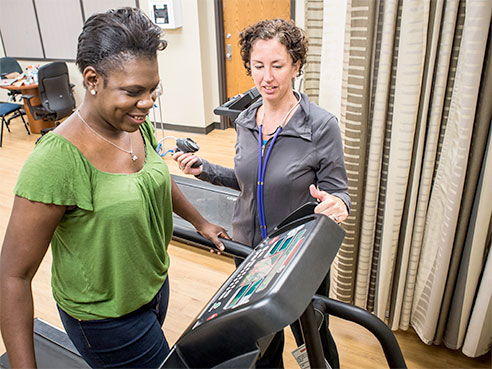 The University of Alabama at Birmingham has reopened enrollment of a unique research study to find ways to help breast cancer survivors begin and sustain an exercise program, with the overall goal of producing positive lifestyle change.
The University of Alabama at Birmingham has reopened enrollment of a unique research study to find ways to help breast cancer survivors begin and sustain an exercise program, with the overall goal of producing positive lifestyle change.
The study will employ a metabolism measurement tool not previously available for this type of physical activity study in cancer survivors. UAB researchers are hoping to enroll 75 more women in Alabama and 50 more at a study site in Illinois.
Doctors and patients are increasingly aware of the importance of physical activity for breast cancer survivors. Being more physically active can improve a woman’s quality of life and may possibly reduce her risk of cancer recurrence.
“Unfortunately, many women with a history of breast cancer know they should be doing more exercise but are unable to do so for a variety of reasons,” said Laura Rogers, M.D., professor in the UAB Department of Nutrition Sciences and principal investigator of the study. “We continue to work toward developing programs that will help such women become and remain more physically active.”
| “Unfortunately, many women with a history of breast cancer know they should be doing more exercise but are unable to do so for a variety of reasons. We continue to work toward developing programs that will help such women become and remain more physically active.” |
In collaboration with scientists at the National Cancer Institute, the UAB study will use a state-of-the-art metabolism measurement tool that should help patients and scientists know how to best use physical activity monitoring devices to improve health and well-being after breast cancer.
“This is a unique and exciting opportunity for us to better understand how well and why our program may be beneficial,” Rogers said.
The Better Exercise Adherence after Treatment for Cancer (BEAT Cancer) study is funded by a federal grant from the NCI. Researchers are enrolling women who have had a breast cancer diagnosis, are finished with treatment and are not engaged in a regular exercise program.
“We’re trying to give breast cancer survivors the tools they need to start an exercise program, and we want to determine what pathways lead them to continue exercising long after their treatment has ended,” Rogers said. “We want to know what kind of support they need.”
Half of the women who enroll will be randomly assigned to receive the BEAT Cancer program. The 12-week program encourages women to walk at a healthy pace, beginning with 20 minutes a day, three times a week and working toward the recommended 150 minutes a week. Those interested in participating can call 205-975-1247 or email moveforward@uab.edu for more information.
During the program’s first six weeks, enrollees will receive coaching from an exercise specialist and learn how to use a heart-rate monitor. Volunteers will be responsible for maintaining their own exercise regimen at home in the last weeks of the program, but an exercise specialist will be available for support.
So far, participants randomized to receive the BEAT Cancer program report benefiting from knowledge gained about exercise-related issues both in general and specific to breast cancer survivors, as well as the accountability that this program provides. Many state that the program has been a valued jump-start to adopting heathier habits and has helped them return to a sense of normalcy after treatment.
Study participants will have follow-up visits at three, six and 12 months for physical assessments to observe progress and changes over time. The women who are not assigned to receive the program will receive three free exercise sessions with a cancer exercise trainer at their completion of the study.
Rogers hopes the study will lead to the creation of implementation and training materials that can be taken to cancer centers around the country to train staff on how to incorporate these interventions for their patients. With the NCI approval to expand the project, Rogers also hopes to better understand how the program changes metabolism and the optimal use of the devices used to measure physical activity.